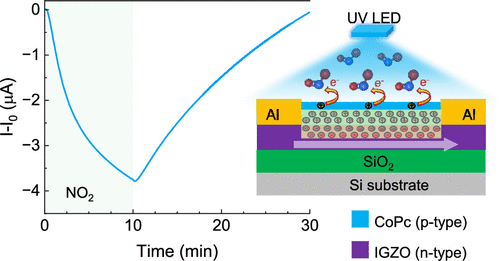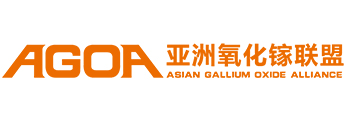

【Device Papers】Nanometer-Thick Films of Cobalt Phthalocyanine/Indium–Gallium–Zinc Oxide Heterojunctions for Ultraviolet-Assisted Recoverable NO₂ Gas Sensors
日期:2025-07-25阅读:277
Researchers from the Thammasat University have published a dissertation titled "Nanometer-Thick Films of Cobalt Phthalocyanine/Indium–Gallium–Zinc Oxide Heterojunctions for Ultraviolet-Assisted Recoverable NO2 Gas Sensors" in ACS Applied Nano Materials.

Abstract
Nitrogen dioxide (NO2) is a major source of air pollution and is known to cause severe respiratory diseases and lung cancer. A high-accuracy and reliable gas sensor is, therefore, essential for effectively tracking and managing human exposure to NO2. Herein, we demonstrate highly sensitive and NO2 selective gas sensors operating at room temperature under ultraviolet (UV)-light illumination. The gas sensor, based on a p–n heterojunction structure, was fabricated by vertically stacking a nanometer-thick layer of p-type cobalt phthalocyanine (CoPc) on a solution-processed n-type indium–gallium–zinc oxide (IGZO) film. The upper CoPc layer interacts directly with the gas molecules, causing changes in the charge distribution and depletion region at the CoPc/IGZO interface. This interaction significantly contributes to the sensing properties of the sensor. With UV activation, the CoPc/IGZO sensor demonstrated high sensitivity to NO2 gas with fast response and full recovery behaviors. At an optimized UV intensity of 20 mW/cm2, the sensor achieved a high sensing response of 66.52% upon exposure to 5 ppm NO2 gas, with a low detection limit of 150 ppb. Additionally, the sensors exhibited long-term stability and robustness under high-temperature and humidity conditions. Furthermore, high selectivity to NO2 gas was observed, attributed to the strong interaction between CoPc and NO2 gas molecules, as investigated using density functional theory. The electron withdrawal by the NO2 molecule facilitates the depletion region at the CoPc/IGZO interface, resulting in a decrease in the sensing current. In contrast, electron donation from ammonia and hydrogen sulfide narrows the depletion region, leading to a higher conductivity channel and an increase in current. These results demonstrate that the CoPc/IGZO sensor is a promising platform for NO2 detection in environmental applications.
DOI:
https://doi.org/10.1021/acsanm.5c01989


